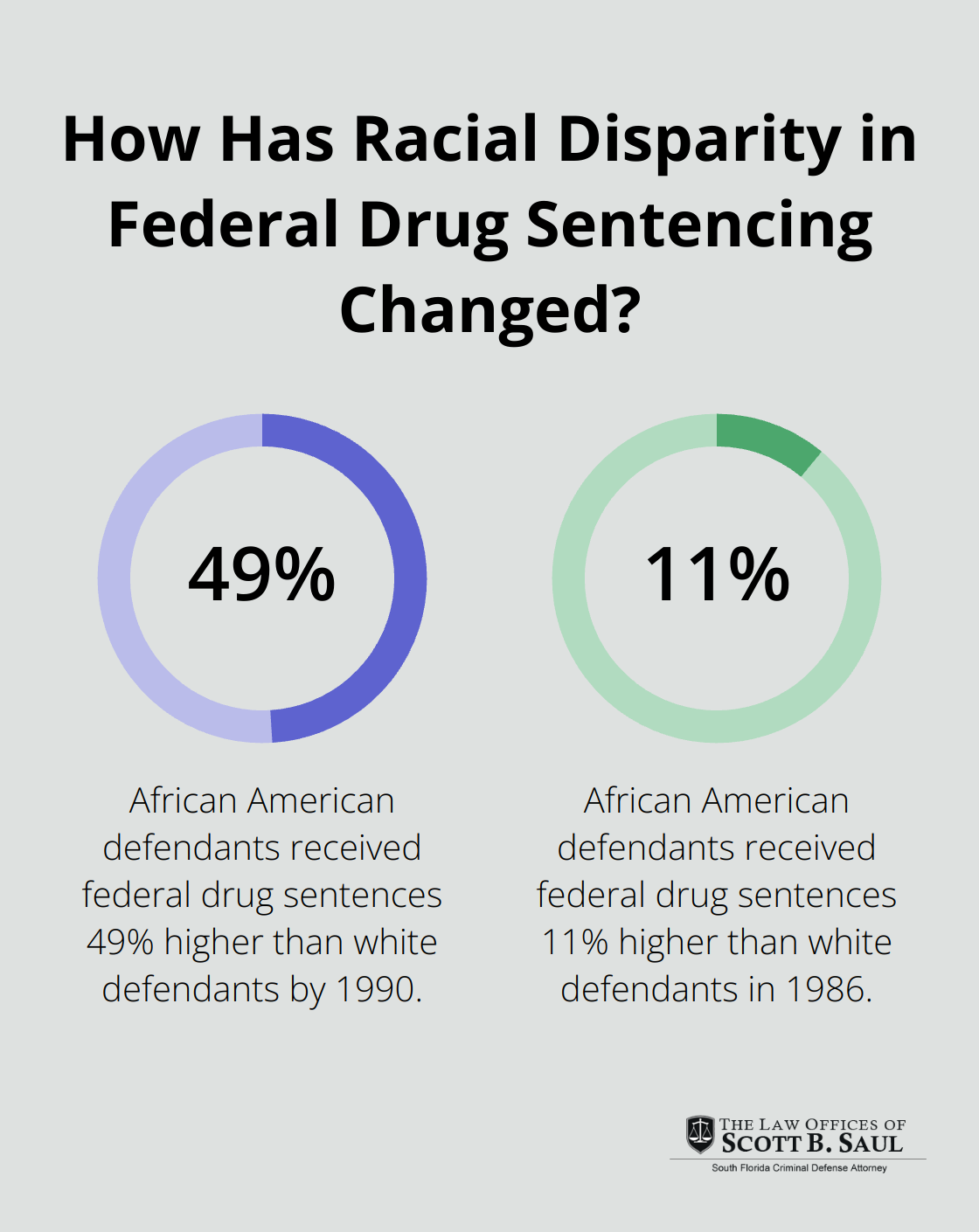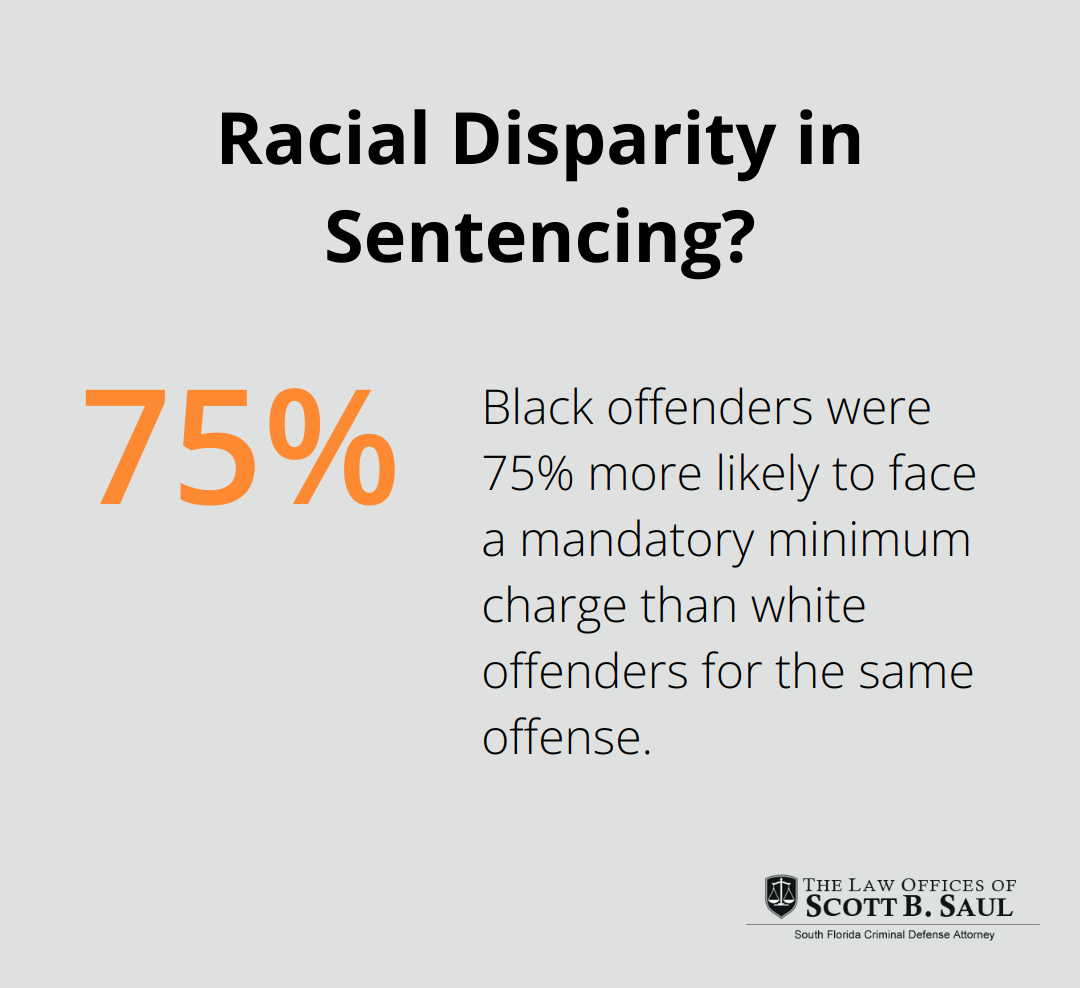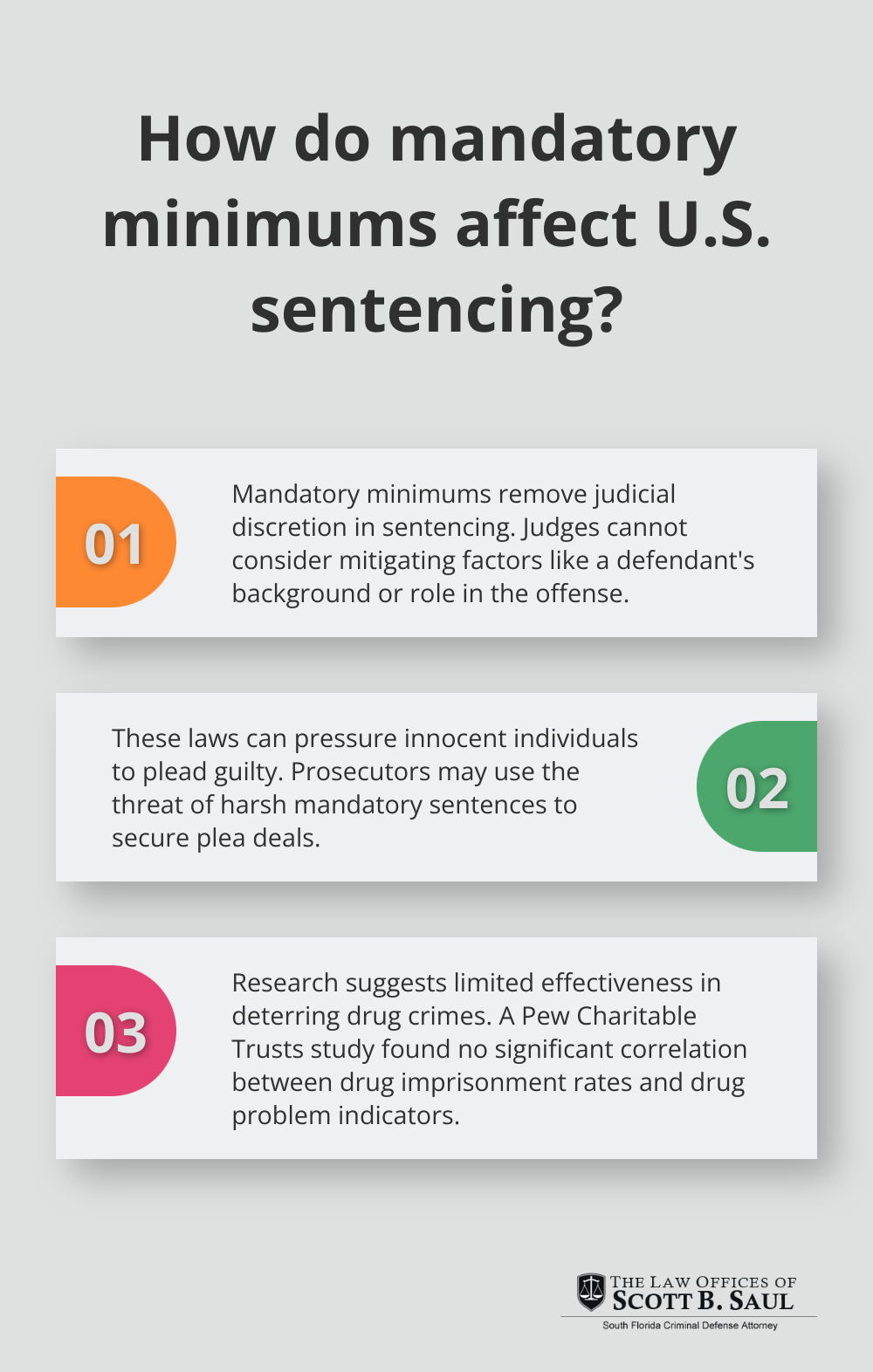How Mandatory Minimum Sentences Affect Drug Cases
By : saulcrim | Category : Criminal Defense | Comments Off on How Mandatory Minimum Sentences Affect Drug Cases
5th Dec 2024

Mandatory minimum sentences for drug offenses have significantly shaped the landscape of criminal justice in the United States. At Law Offices of Scott B. Saul, we’ve witnessed firsthand how these rigid sentencing guidelines impact individuals facing drug charges.
These laws, designed to deter drug-related crimes, have sparked intense debate about their effectiveness and fairness. This post examines the far-reaching consequences of mandatory minimums on drug cases and explores the ongoing controversies surrounding their application.
What Are Mandatory Minimum Sentences?
Definition and Origin
Mandatory minimum sentences represent predetermined prison terms for specific drug offenses. These laws remove judicial discretion in sentencing. The 1980s saw the emergence of these sentences as part of the “War on Drugs,” with the goal to deter drug-related crimes and ensure consistent punishments across cases.
The Anti-Drug Abuse Act of 1986
The Anti-Drug Abuse Act of 1986 marked a significant shift in U.S. drug policy. It provided for increased penalties for violations of the Controlled Substances Act and raised authorization ceilings for drug law enforcement. The act introduced a controversial 100:1 sentencing disparity between crack and powder cocaine, which led to disproportionately harsh sentences for crack cocaine offenses.

The U.S. Sentencing Commission reported a stark increase in sentencing disparities. By 1990, African American defendants received federal drug sentences 49% higher than white defendants, up from 11% in 1986. This increase highlights the unintended consequences of these rigid sentencing structures.
Common Drug Offenses with Mandatory Minimums
Drug trafficking offenses frequently carry mandatory minimum sentences. Specific drug quantities often trigger these sentences. For example, possession of 5 grams of methamphetamine or 500 grams of cocaine can result in a 5-year mandatory minimum sentence.
Manufacturing and distribution charges also commonly fall under mandatory minimum laws. The severity of the sentence typically correlates with the type and quantity of drugs involved. Repeat offenders face even harsher penalties, with mandatory minimums doubling or tripling for subsequent convictions.
Impact on Sentencing Outcomes
The implementation of mandatory minimums has resulted in longer average sentences for drug offenses. These sentencing structures significantly impact case outcomes. The threat of lengthy mandatory sentences often influences plea bargaining, potentially pressuring defendants to accept plea deals rather than risk trial.
The Ongoing Debate
The rigid nature of mandatory minimum sentences continues to fuel debates about their effectiveness and fairness. Critics argue that these laws remove the ability to consider individual circumstances in sentencing, potentially leading to unjust outcomes. Proponents maintain that mandatory minimums serve as a strong deterrent to drug crimes.
As we move forward, it’s important to examine how these sentencing laws affect different aspects of the criminal justice system, from individual cases to broader societal impacts.
The Real Cost of Mandatory Minimums
Overcrowded Prisons and Skyrocketing Costs
Mandatory minimum sentences have altered the landscape of drug-related cases in the United States. The implementation of these rigid sentencing guidelines has led to a dramatic increase in incarceration rates for drug offenses. According to the Federal Bureau of Prisons, 31.0% of individuals in federal prison are serving a sentence for an offense involving a weapon. This surge has resulted in severe overcrowding in federal prisons, which operate at 103% capacity as of 2022.

The financial burden of this increased incarceration is staggering. The annual cost to house a federal inmate averages $39,158 (as reported by the Federal Register in 2021). This translates to billions of taxpayer dollars spent on incarceration rather than rehabilitation or community programs.
Unequal Justice: The Racial Divide
The most troubling aspect of mandatory minimums is their disproportionate impact on minority communities. The U.S. Sentencing Commission’s 2017 report revealed that Black offenders were 75% more likely to face a mandatory minimum charge than white offenders for the same offense.
This racial disparity extends to sentencing outcomes. For instance, the average sentence for Black drug offenders is 11.3% longer than for white offenders in similar cases. These statistics paint a stark picture of systemic inequality within the justice system, perpetuated by inflexible sentencing laws.
Judges’ Hands Tied
Mandatory minimums significantly reduce judicial discretion, often forcing judges to impose sentences they believe are unjust. A report by the U.S. Sentencing Commission suggests that an unintended effect of mandatory minimums is unwarranted sentencing uniformity.
This lack of flexibility prevents judges from considering mitigating factors such as the defendant’s role in the offense, personal history, or potential for rehabilitation. As a result, low-level offenders often receive disproportionately harsh sentences, which undermines the principle of individualized justice.
The Ripple Effect on Communities
The impact of mandatory minimums extends far beyond the courtroom. Families of incarcerated individuals often face financial hardship, emotional trauma, and social stigma. Children with incarcerated parents are more likely to experience poverty, behavioral issues, and academic struggles.
Communities, particularly those already facing economic challenges, suffer from the loss of productive members and the strain on social services. This creates a cycle of disadvantage that can persist for generations.
The far-reaching consequences of mandatory minimums raise important questions about their effectiveness and fairness. As we examine these issues, it becomes clear that alternative approaches to drug offenses may better serve both justice and society.
The Flaws of One-Size-Fits-All Justice
Inflexibility in Sentencing
Mandatory minimum sentences face intense scrutiny from legal experts, policymakers, and advocacy groups. These rigid sentencing structures often fail to account for the nuances of individual cases, which leads to potentially unjust outcomes.

The core issue with mandatory minimums lies in their inflexibility. They remove a judge’s ability to consider mitigating factors such as a defendant’s background, role in the offense, or potential for rehabilitation. This one-size-fits-all approach can result in disproportionately harsh sentences for low-level offenders.
A first-time offender caught with a small amount of drugs for personal use might face the same mandatory sentence as a repeat offender involved in large-scale distribution. This lack of distinction undermines the principle of proportional justice and can erode public faith in the legal system.
Unintended Consequences
Mandatory minimums often produce unintended consequences that extend beyond the courtroom. Prosecutors may use the threat of harsh mandatory sentences as leverage to secure plea deals, even in cases where the evidence might not support a conviction at trial. This practice can pressure innocent individuals to plead guilty to avoid the risk of lengthy incarceration.
These sentencing laws can inadvertently benefit high-level drug offenders. Those with more information to trade often receive reduced sentences for cooperation, while low-level offenders with less valuable information face full mandatory terms. This paradox undermines the intended purpose of targeting major drug traffickers.
Limited Deterrent Effect
Despite their intended purpose, research suggests that mandatory minimums have limited effectiveness in deterring drug crimes. A study by the Pew Charitable Trusts found no significant correlation between drug imprisonment rates and three indicators of drug problems: self-reported drug use, drug overdose deaths, and drug arrests.
The U.S. Sentencing Commission released several data reports in 2023 that provide useful federal sentencing information to the criminal justice community, policymakers, and others.
Impact on Judicial Discretion
Mandatory minimums significantly reduce judicial discretion, often forcing judges to impose sentences they believe are unjust. This lack of flexibility prevents judges from considering important factors such as the defendant’s role in the offense, personal history, or potential for rehabilitation.
As a result, low-level offenders often receive disproportionately harsh sentences, which undermines the principle of individualized justice. This rigid approach to sentencing fails to address the unique circumstances of each case and can lead to outcomes that neither serve justice nor benefit society.
The Need for Experienced Legal Representation
The complexities of mandatory minimum laws underscore the importance of seeking experienced legal representation for individuals facing drug charges. Understanding these laws and their potential impact is essential for mounting an effective defense strategy. Attorneys with expertise in this area can navigate the intricacies of the legal system and work to achieve the best possible outcome for their clients.
Final Thoughts
Mandatory minimum sentences for drug offenses have reshaped the American criminal justice system. These rigid structures have increased incarceration rates, overcrowded prisons, and disproportionately affected minority communities. The removal of judicial discretion has often resulted in punishments that don’t fit the crime, raising questions about fairness and effectiveness.

Recent trends show a growing recognition of flaws in mandatory minimum sentencing. Some states have reformed their laws, moving away from one-size-fits-all approaches. At the federal level, bipartisan support for sentencing reform has increased, with proposals to reduce or eliminate mandatory minimums for certain non-violent drug offenses.
Understanding the implications of mandatory minimums is crucial for individuals facing drug charges. These laws can significantly impact case outcomes and potential sentences. At Law Offices of Scott B. Saul, we work to protect our clients’ rights and pursue the best possible outcomes in their cases (drawing from our experience as former prosecutors).
Archives
- April 2025 (7)
- March 2025 (9)
- February 2025 (8)
- January 2025 (9)
- December 2024 (10)
- November 2024 (5)
- July 2024 (2)
- June 2024 (2)
- May 2024 (2)
- April 2024 (2)
- March 2024 (2)
- February 2024 (2)
- January 2024 (2)
- December 2023 (2)
- November 2023 (2)
- October 2023 (2)
- September 2023 (2)
- August 2023 (1)
- July 2023 (2)
- June 2023 (2)
- May 2023 (2)
- April 2023 (2)
- March 2023 (2)
- February 2023 (2)
- January 2023 (2)
- December 2022 (2)
- November 2022 (2)
- October 2022 (2)
- September 2022 (2)
- August 2022 (2)
- July 2022 (2)
- June 2022 (2)
- May 2022 (2)
- April 2022 (2)
- March 2022 (2)
- February 2022 (2)
- January 2022 (2)
- December 2021 (2)
- November 2021 (2)
- October 2021 (2)
- September 2021 (2)
- August 2021 (2)
- July 2021 (2)
- June 2021 (2)
- May 2021 (2)
- April 2021 (2)
- September 2020 (5)
- July 2020 (4)
- June 2020 (4)
- May 2020 (4)
- April 2020 (5)
- March 2020 (4)
- February 2020 (4)
- January 2020 (4)
- December 2019 (1)
- November 2019 (4)
- October 2019 (4)
- September 2019 (4)
- August 2019 (4)
- July 2019 (5)
- June 2019 (4)
- May 2019 (4)
- April 2019 (4)
- March 2019 (4)
- February 2019 (4)
- January 2019 (4)
- December 2018 (4)
- November 2018 (5)
- October 2018 (5)
- September 2018 (4)
- August 2018 (4)
- July 2018 (7)
- June 2018 (4)
- May 2018 (4)
- April 2018 (8)
- March 2018 (4)
- February 2018 (4)
- January 2018 (4)
- November 2017 (4)
- October 2017 (4)
- September 2017 (4)
- August 2017 (7)
- July 2017 (6)
- June 2017 (4)
- May 2017 (4)
- April 2017 (4)
- March 2017 (4)
- February 2017 (7)
- January 2017 (4)
- December 2016 (7)
- November 2016 (4)
- October 2016 (4)
- September 2016 (10)
- August 2016 (4)
- July 2016 (4)
- June 2016 (4)
- May 2016 (4)
- April 2016 (4)
- March 2016 (4)
- February 2016 (7)
- January 2016 (4)
- December 2015 (5)
- November 2015 (4)
- October 2015 (7)
- September 2015 (4)
- August 2015 (4)
- July 2015 (13)
- June 2015 (9)
- May 2015 (8)
- April 2015 (6)
- March 2015 (4)
- February 2015 (4)
- January 2015 (4)
- December 2014 (4)
- November 2014 (4)
- October 2014 (4)
- September 2014 (3)
Categories
- Adjudication (1)
- Bankruptcy (1)
- Burglary Crimes (3)
- calendar call (1)
- Car Accident (1)
- Criminal Defense (312)
- Cyber Crimes (7)
- DNA (1)
- Domestic Violence (9)
- Drug Crimes (5)
- DUI (12)
- Embezzlement (1)
- Environmental Crimes (4)
- Expungement Law (2)
- Federal Sentencing Law (3)
- Firearm (3)
- Forgery (4)
- General (82)
- Healthcare (3)
- Immigration (1)
- Indentity Theft (1)
- Insurance (5)
- judicial sounding (2)
- Juvenile Crimes (4)
- Manslaughter (4)
- Money Laundering (3)
- Organized Crime (1)
- Racketeering (1)
- Reckless Driving (3)
- RICO (3)
- Sealing and Expunging (2)
- Sex Offense (1)
- Shoplifting (1)
- Suspended Driver's License (1)
- Traffic (4)
- Trending Topics (1)
- White-collar Offenses (1)

